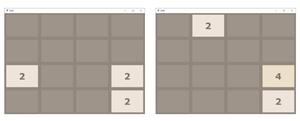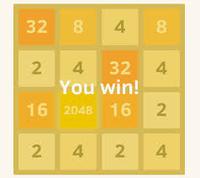2048 Computer Programming
In this article we will look python code and logic to design a 2048 game you have played very often in your smartphone. If you are not familiar with the game, it is highly recommended to first play the game so that you can understand the basic functioning of it.
How to play 2048 :
Attention geek! Strengthen your foundations with the Python Programming Foundation Course and learn the basics.
To begin with, your interview preparations Enhance your Data Structures concepts with the Python DS Course. And to begin with your Machine Learning Journey, join the Machine Learning - Basic Level Course
1. There is a 4*4 grid which can be filled with any number. Initially two random cells are filled with 2 in it. Rest cells are empty.

2. we have to press any one of four keys to move up, down, left, or right. When we press any key, the elements of the cell move in that direction such that if any two identical numbers are contained in that particular row (in case of moving left or right) or column (in case of moving up and down) they get add up and extreme cell in that direction fill itself with that number and rest cells goes empty again.

3. After this grid compression any random empty cell gets itself filled with 2.

4. Following the above process we have to double the elements by adding up and make 2048 in any of the cell. If we are able to do that we wins.

5. But if during the game there is no empty cell left to be filled with a new 2, then the game goes over.

In above process you can see the snapshots from graphical user interface of 2048 game. But all the logic lies in the main code. So to solely understand the logic behind it we can assume the above grid to be a 4*4 matrix ( a list with four rows and four columns). You can see below the way to take input and output without GUI for the above game.
Example :
Commands are as follows : 'W' or 'w' : Move Up 'S' or 's' : Move Down 'A' or 'a' : Move Left 'D' or 'd' : Move Right [0, 0, 0, 0] [0, 0, 0, 0] [0, 0, 0, 0] [0, 0, 2, 0] Press the command : a GAME NOT OVER [0, 0, 0, 2] [0, 0, 0, 0] [0, 0, 0, 0] [2, 0, 0, 0] Press the command : s GAME NOT OVER [0, 0, 0, 0] [0, 0, 0, 0] [0, 0, 2, 0] [2, 0, 0, 2] Press the command : d GAME NOT OVER [0, 0, 0, 0] [0, 0, 0, 0] [2, 0, 0, 2] [0, 0, 0, 4] Press the command : a GAME NOT OVER [0, 2, 0, 0] [0, 0, 0, 0] [4, 0, 0, 0] [4, 0, 0, 0] Press the command : s GAME NOT OVER [0, 0, 0, 0] [0, 0, 0, 0] [0, 0, 0, 0] [8, 2, 0, 2] . . . And the series of input output will go on till we lose or win!
Programming Approach :
- We will design each logic function such as we are performing a left swipe then we will use it for right swipe by reversing matrix and performing left swipe.
- Moving up can be done by taking transpose then moving left.
- Moving down can be done by taking transpose the moving right.
- All the logic in the program are explained in detail in the comments. Highly recommended to go through all the comments.
We have two python files below, one is 2048.py which contains main driver code and the other is logic.py which contains all functions used. logic.py should be imported in 2048.py to use these functions. just place both the files in the same folder then run 2048.py will work perfectly.
logic.py
Python3
import random
def start_game():
mat = []
for i in range ( 4 ):
mat.append([ 0 ] * 4 )
print ( "Commands are as follows : " )
print ( "'W' or 'w' : Move Up" )
print ( "'S' or 's' : Move Down" )
print ( "'A' or 'a' : Move Left" )
print ( "'D' or 'd' : Move Right" )
add_new_2(mat)
return mat
def add_new_2(mat):
r = random.randint( 0 , 3 )
c = random.randint( 0 , 3 )
while (mat[r] ! = 0 ):
r = random.randint( 0 , 3 )
c = random.randint( 0 , 3 )
mat[r] = 2
def get_current_state(mat):
for i in range ( 4 ):
for j in range ( 4 ):
if (mat[i][j] = = 2048 ):
return 'WON'
for i in range ( 4 ):
for j in range ( 4 ):
if (mat[i][j] = = 0 ):
return 'GAME NOT OVER'
for i in range ( 3 ):
for j in range ( 3 ):
if (mat[i][j] = = mat[i + 1 ][j] or mat[i][j] = = mat[i][j + 1 ]):
return 'GAME NOT OVER'
for j in range ( 3 ):
if (mat[ 3 ][j] = = mat[ 3 ][j + 1 ]):
return 'GAME NOT OVER'
for i in range ( 3 ):
if (mat[i][ 3 ] = = mat[i + 1 ][ 3 ]):
return 'GAME NOT OVER'
return 'LOST'
def compress(mat):
changed = False
new_mat = []
for i in range ( 4 ):
new_mat.append([ 0 ] * 4 )
for i in range ( 4 ):
pos = 0
for j in range ( 4 ):
if (mat[i][j] ! = 0 ):
new_mat[i][pos] = mat[i][j]
if (j ! = pos):
changed = True
pos + = 1
return new_mat, changed
def merge(mat):
changed = False
for i in range ( 4 ):
for j in range ( 3 ):
if (mat[i][j] = = mat[i][j + 1 ] and mat[i][j] ! = 0 ):
mat[i][j] = mat[i][j] * 2
mat[i][j + 1 ] = 0
changed = True
return mat, changed
def reverse(mat):
new_mat = []
for i in range ( 4 ):
new_mat.append([])
for j in range ( 4 ):
new_mat[i].append(mat[i][ 3 - j])
return new_mat
def transpose(mat):
new_mat = []
for i in range ( 4 ):
new_mat.append([])
for j in range ( 4 ):
new_mat[i].append(mat[j][i])
return new_mat
def move_left(grid):
new_grid, changed1 = compress(grid)
new_grid, changed2 = merge(new_grid)
changed = changed1 or changed2
new_grid, temp = compress(new_grid)
return new_grid, changed
def move_right(grid):
new_grid = reverse(grid)
new_grid, changed = move_left(new_grid)
new_grid = reverse(new_grid)
return new_grid, changed
def move_up(grid):
new_grid = transpose(grid)
new_grid, changed = move_left(new_grid)
new_grid = transpose(new_grid)
return new_grid, changed
def move_down(grid):
new_grid = transpose(grid)
new_grid, changed = move_right(new_grid)
new_grid = transpose(new_grid)
return new_grid, changed
Python3
import random
def start_game():
mat = []
for i in range ( 4 ):
mat.append([ 0 ] * 4 )
print ( "Commands are as follows : " )
print ( "'W' or 'w' : Move Up" )
print ( "'S' or 's' : Move Down" )
print ( "'A' or 'a' : Move Left" )
print ( "'D' or 'd' : Move Right" )
add_new_2(mat)
return mat
def add_new_2(mat):
r = random.randint( 0 , 3 )
c = random.randint( 0 , 3 )
while (mat[r] ! = 0 ):
r = random.randint( 0 , 3 )
c = random.randint( 0 , 3 )
mat[r] = 2
def get_current_state(mat):
for i in range ( 4 ):
for j in range ( 4 ):
if (mat[i][j] = = 2048 ):
return 'WON'
for i in range ( 4 ):
for j in range ( 4 ):
if (mat[i][j] = = 0 ):
return 'GAME NOT OVER'
for i in range ( 3 ):
for j in range ( 3 ):
if (mat[i][j] = = mat[i + 1 ][j] or mat[i][j] = = mat[i][j + 1 ]):
return 'GAME NOT OVER'
for j in range ( 3 ):
if (mat[ 3 ][j] = = mat[ 3 ][j + 1 ]):
return 'GAME NOT OVER'
for i in range ( 3 ):
if (mat[i][ 3 ] = = mat[i + 1 ][ 3 ]):
return 'GAME NOT OVER'
return 'LOST'
def compress(mat):
changed = False
new_mat = []
for i in range ( 4 ):
new_mat.append([ 0 ] * 4 )
for i in range ( 4 ):
pos = 0
for j in range ( 4 ):
if (mat[i][j] ! = 0 ):
new_mat[i][pos] = mat[i][j]
if (j ! = pos):
changed = True
pos + = 1
return new_mat, changed
def merge(mat):
changed = False
for i in range ( 4 ):
for j in range ( 3 ):
if (mat[i][j] = = mat[i][j + 1 ] and mat[i][j] ! = 0 ):
mat[i][j] = mat[i][j] * 2
mat[i][j + 1 ] = 0
changed = True
return mat, changed
def reverse(mat):
new_mat = []
for i in range ( 4 ):
new_mat.append([])
for j in range ( 4 ):
new_mat[i].append(mat[i][ 3 - j])
return new_mat
def transpose(mat):
new_mat = []
for i in range ( 4 ):
new_mat.append([])
for j in range ( 4 ):
new_mat[i].append(mat[j][i])
return new_mat
def move_left(grid):
new_grid, changed1 = compress(grid)
new_grid, changed2 = merge(new_grid)
changed = changed1 or changed2
new_grid, temp = compress(new_grid)
return new_grid, changed
def move_right(grid):
new_grid = reverse(grid)
new_grid, changed = move_left(new_grid)
new_grid = reverse(new_grid)
return new_grid, changed
def move_up(grid):
new_grid = transpose(grid)
new_grid, changed = move_left(new_grid)
new_grid = transpose(new_grid)
return new_grid, changed
def move_down(grid):
new_grid = transpose(grid)
new_grid, changed = move_right(new_grid)
new_grid = transpose(new_grid)
return new_grid, changed
2048.py
Python3
import logic
if __name__ = = '__main__' :
mat = logic.start_game()
while ( True ):
x = input ( "Press the command : " )
if (x = = 'W' or x = = 'w' ):
mat, flag = logic.move_up(mat)
status = logic.get_current_state(mat)
print (status)
if (status = = 'GAME NOT OVER' ):
logic.add_new_2(mat)
else :
break
elif (x = = 'S' or x = = 's' ):
mat, flag = logic.move_down(mat)
status = logic.get_current_state(mat)
print (status)
if (status = = 'GAME NOT OVER' ):
logic.add_new_2(mat)
else :
break
elif (x = = 'A' or x = = 'a' ):
mat, flag = logic.move_left(mat)
status = logic.get_current_state(mat)
print (status)
if (status = = 'GAME NOT OVER' ):
logic.add_new_2(mat)
else :
break
elif (x = = 'D' or x = = 'd' ):
mat, flag = logic.move_right(mat)
status = logic.get_current_state(mat)
print (status)
if (status = = 'GAME NOT OVER' ):
logic.add_new_2(mat)
else :
break
else :
print ( "Invalid Key Pressed" )
print (mat)
Output :
Source: https://www.geeksforgeeks.org/2048-game-in-python/

0 Response to "2048 Computer Programming"
Post a Comment